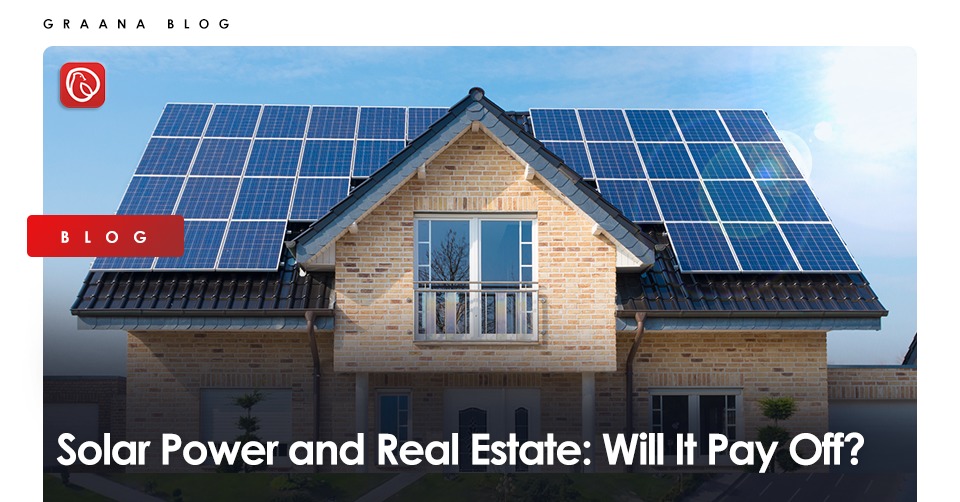
Over the last couple of decades, energy needs have skyrocketed due to industrialisation, urbanization and transportation. Governments are heavily relying on non-renewable energy sources to meet these demands. Since their reserves are limited, they are depleting drastically. In the future, this will catastrophically impact the real estate sector as well as the overall economic growth of countries. However, with solar energy and a move towards renewable energy sources, sustainable living can be achieved.
Graana.com brings you the benefits of solar energy in real estate.
The sun has been used throughout history as a major source of energy. In the mid 1800s, during the industrial revolution, advances were made that allowed the solar energy to be used to produce steam for machinery. This supplemented the railway network which previously solely relied on coal for energy. It was only in 1839 that the photovoltaic effect was discovered whereby energy from the sun was converted into electric energy. This laid the foundation for the modern-day solar cell which uses the solar energy and converts it into electricity for daily use.
Sunlight is free and readily available. Solar energy can be converted into electric energy. The process makes use of photovoltaic or solar cells through the photoelectric effect. In simple words, photoelectric effects means that when light is shone onto matter, a small amount of current is produced which flows through it. These currents are essentially electrons that are provided with energy from a light source – the sun. These electrons gain energy to move around producing current.
Through this process, only a small amount of energy is produced. However, when these cells are clubbed together to form a panel, they generate significant energy that can sustain entire houses and properties.
Light from the sun is only available for a few hours everyday. Therefore, storage of energy is important to make sure electricity is available for household uses. Thus, energy should be stored for later use.
For this purpose, rechargeable batteries are utilised to ensure electricity supply when the sun is down. The batteries are able to recharge and discharge to ensure this. However, with the help of a regulator, these batteries are prevented from being overcharged. It also saves them from electrical damage.
Solar energy is renewable and one of the essential elements of sustainable development. Given the rapid depletion of natural resources, solar power can provide an excellent alternative to meet the burgeoning requirements of growing population and thereby electricity needs. Governments are increasingly planning to incorporate solar power into urban planning to ensure sustainable development is undertaken.
Experts have been ringing the bells for years that our natural sources are depleting faster than they can be naturally replenished. Although urban planners have been mindful of the circumstances, substantive actions have not been taken by most countries to switch to renewable sources of energy.
Burning of non-renewable fossil fuels like coal, oil and natural gas not only generate electricity but they also severely damage the environment. They are one of the major contributors to air pollution. For cities to be more sustainable, a move towards renewable energy has to be made to protect the environment. In places where sun is abundant, solar power can help solve this dilemma.
Solar power is increasingly becoming popular in urban centres as well as remote locations because of its monetary benefits. Although the initial installation cost may be significant, over the years, the return value on investment is promising. Within a few years, the reduction in electricity costs covers the initial investment.
The maintenance cost of these panels are also affordable because these solar panels have a long life span and may last for decades in certain cases. All they need is a little maintenance and cleaning from time to time to ensure they work in perfect condition.
Solar power is one of the most viable solutions for electricity needs in remote locations which are not connected with the main grid. Laying new cables and securing supply to these places are costly and often ignored by governments. For these locations, installation of simple panels to generate electricity can solve the problem. The electricity generated can then be used to power day to day appliances and create a self sustaining system. This can play a key role in the flourishing of the real estate industry and development in the remote areas.
Most developing countries, including Pakistan, are ensnared in energy shortages. The demand outstrips the supply creating a cyclical system of stagnant economic growth and poverty. Due to unavailability of electricity, factories are not operating at their full potential. As a result, job creation is minimal. This translates into low economic growth and even less revenue to produce more energy.
Transferring to solar energy can help countries solve their energy woes. It is a source that is renewable, cost effective and long lasting. If solar energy is developed and installed at a larger scale in countries with abundant light, the power generated can be used to supplement existing energy sources. The overall benefits will have far reaching consequences.
For more information such as how to solve load shedding problem in Pakistan, visit Graana.com
ISLAMABAD: The Capital Development Authority (CDA) is looking to the federal government for an additional…
ISLAMABAD: The Capital Development Authority (CDA) and the Asian Development Bank (ADB) have entered into…
Islamabad: The Capital Development Authority (CDA) has announced plans to issue possession letters to allottees…
Islamabad, [24 March 2025] – Graana.com, Pakistan's leading online real estate marketplace, is proud to…
Islamabad, Pakistan – March 2025: Graana.com, Pakistan’s leading real estate platform, has proudly partnered with…
KARACHI: Sindh Local Government Minister Saeed Ghani chaired a meeting on Monday to review measures…